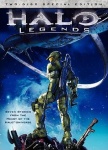
Halo Legends DVD
Publisher: Warner Bros. Animation
Creators: Daisuke Nishio, Frank O’Connor, Hideki Futamura
Release Date: February 16, 2010
Price: Single-Disc $19.98; 2-Disc Sp. Ed. $29.98; BD $34.98
Running Time: 119 min.
Format: Eight-Part Anthology
Age Rating: PG-13
ICv2 Rating: 4 Stars out of 5
Following the pattern established by the Animatrix and Batman: Gotham Knight, Halo Legends is an anthology film based on the popular first person-shooter video game featuring anime segments from five different studios. These anthologies typically serve a dual purpose, providing background information about the property on the one hand and giving fans of the franchise some new thrills or insights that are only possible with animation.
One might think that a first person-shooter game like Halo (“see critter, shoot critter”) doesn’t require much of backstory, but that would be wrong. The first two segments in Halo Legends (“Origins Part 1,” and “Origins Part 2”) detail the origins of the conflicts in the Halo game in some detail and also set the mood for what follows.
Animated by Studio 4*C, the “Origins” sequences take up where Halo 3 ended, with the Master Chief in cryogenic storage and Cortana, the faithful AI robot, watching over him. She narrates the story of how the Forerunners, overwhelmed by hordes of parasitic creatures known as the Flood, created the Halo rings, which destroyed and then repopulated the galaxy. This was followed by mankind’s combat-filled rise to prominence and its eventual outer space conflict with the Covenant, a combat that is only suspended when a revival of the Flood threatens to overwhelm both sides.
For someone like this reviewer who is not a “thumb jockey,” the well-produced “Origins” segments are an excellent introduction to the Halo universe. But to this outsider at least, the best sequence comes next. “The Duel,” directed by Hiroshi Yamazaki and produced by Production I.G., is striking in just about every way. Unlike the hard-edged, realistic style of animation favored in the other segments, every edge in “The Duel” is softened by impressionistic brush strokes, yet the sequence has some of the best combat depicted in the entire film and the action loses none of its impact.
Set entirely on an alien planet where the quasi-reptilian Covenant-like hero is a ferocious warrior who has earned the key position of arbiter, “The Duel” explores the ambiguities of loyalty and integrity, which can often be at cross purposes. The Arbiter’s failure to go along with the conventional patterns of his militaristic society has consequences. With its samurai-like armor, sword play, and samisen-flavored score, “The Duel” reflects traditional Japanese culture more directly than any other segment in the anthology.
Production I.G. is also responsible for “Homecoming,” which was directed by Koji Sawai and looks like a typical cleanly-animated, hard-edge production from the studio responsible for Ghost in the Shell: Stand Alone Complex. Slipping back and forth in time from a hopeless military encounter to the troubled genesis of the “Spartan” program, “Homecoming” provides a troubling behind-the-scenes look at the sacrifices of mankind that were necessitated by the conflict with the Covenant that is at the heart of the Halo game.
Director Daisuke Nishio’s “Odd One Out” is altogether more lighthearted and references traditional anime rather than traditional Japanese culture. Produced by Toei Animation, the studio responsible for Dragon Ball Z, “Odd One Out” features the brightly colored animated style and flying martial arts action that DBZ fans will recognize at once.
If “Odd One Out” echoes the popular anime category that features comic super-powered martial arts slugfests, “Prototype,” which was produced by Bones, pays homage to the mecha genre of anime with a bittersweet story of a sergeant known as “the Ghost,” who helps evacuate his platoon by piloting a prototype mobile combat suit on a suicide mission.
“The Babysitter” from Studio 4*C appears to mirror the action of the actual Halo game as closely as any of the segments. A unit is inserted on a Covenant-controlled planet to carry out a dangerous sniper attack aimed at assassinating a Covenant Prophet, a mission that is jeopardized by a rivalry between a Spartan and a squad of elite non-genetically altered paratroopers.
The final segment, “The Package,” reflects both the look and action of the game with a “balls-to-the-wall” mission in which the Master Chief has to rescue a captured Catherine Halsey from the flagship of a huge Covenant fleet. “The Package” was directed by Shinji Aramaki, the director of the first all CGI anime feature. It is the only segment that is completely computer-animated, so it looks more like a conventional video game than any of the other sequences.
Halo Legends earns its PG-13 rating with plenty of blood and violence as well as some mild profanity (SOBs, etc.). Whether or not it will have much appeal outside of the Halo audience is not all clear, though some of its segments such as “The Duel” are really extraordinary in style (if not necessarily in substance) and worthy of notice by anyone interested in animation.
Since the Halo audience is so large, it is perhaps more important that Halo Legends appeal to those who play the actual Halo game. My suspicion is that “Prototype,” “The Babysitter,” and “The Package,” will be the segments that appeal the most to the game’s dedicated audience. Unless they have some familiarity with Dragon Ball Z, Halo fans may have a problem getting the joke in the “Odd One Out” sequence.
The very nature of these anime anthology films creates a crazy quilt of different animation styles that can be disconcerting, but there is not doubt that Halo Legends adds some depth, context, and more than a little heart to the Halo universe.
--Tom Flinn







